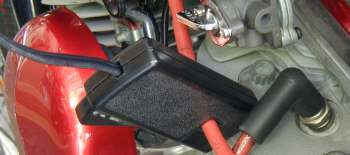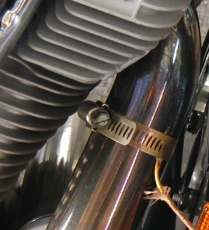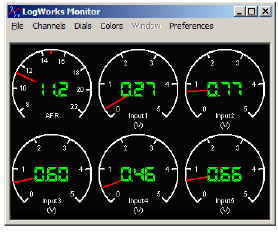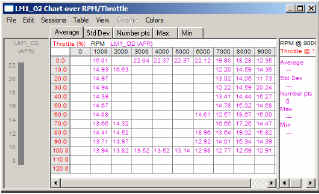The Innovate Motorsports LM-1
Innovate Motorsports' LM-1 portable wide band
oxygen sensor gauge has been on the market for a couple of years now. Its
small size, accuracy, simplicity and low price have made it a popular tool
with the automobile performance crowd. Innovate has also expanded the
usefulness of the LM-1 with an extensive array of add-ons to measure,
display and record most vehicle functions. Surprisingly, this very useful performance
tuning tool has not caught on
with the two-wheeled crowd to the same extent as it has with the four-wheelers.
The LM-1 on a motorcycle
The LM-1's small 4"wx7"hx1.75"d
dimensions make it easy to carry on any motorcycle. While it can be
hand carried, it is more convenient to mount the LM-1 in a
motorcycle tank bag.
Inexpensive magnetic tank bags with map pockets can be purchased for under
$30, making this a good option as a portable mount for the LM-1. The LM-1
can be placed in the map pocket, allowing viewing of the AFR display and
access to the control buttons on the instrument while riding the
motorcycle.
Because few motorcycle exhaust systems have
O2 sensor mounts in the header, a temporary probe was required. Innovate
Motorsports does make a tail pipe mount, but the design is not effective for
use on V-twin motorcycle exhaust systems. A more suitable motorcycle design was
fabricated. The resulting probe was very effective in capturing
accurate fuel ratios. More information on the DIY exhaust probe can be found on Nightrider.com.
The LM-1's +12V round automotive connector was
removed and replaced with a large set of Radio Shack alligator clips. A 5 amp
inline fuse holder was also installed to protect against electrical shorts. An
alternative to the alligator clips would be large ring connectors that
would fit on the standard motorcycle battery bolts.
The standard LM-1 package comes with the portable
data logger, Wide Band Oxygen Sensor, Logworks software, O2 mounting bung
and all cabling required to connect the device to your vehicle and
computer. While the LM-1 allows data logging for the WBO2 air fuel ratio
and up to 5 additional data channels, it requires an optional cable
(LMA-2) or Auxiliary input box (LMA-3) to acquire this data. Because of this the first
test will be of the LM-1 and air fuel ratios only.
You should read the supplied user manual completely
before installing or operating the LM-1. There are some first time use
procedures that must be performed on the LM-1 in order to properly
calibrate the wide band O2 sensor. These procedures are well documented
and laid out in a step-by-step manner in the LM-1 Manual and are required
to maximize the accuracy of the instrument. Least you wonder how sensitive
the O2 sensor is, after calibrating the LM-1 it was able to sense a drop
in oxygen when breathing on the sensor in open air. That is very
sensitive.
Putting the LM-1 on the road
The test motorcycle was a 1997 Harley-Davidson FXD
with an aftermarket Mikuni carburetor and SuperTrapp 2-1 exhaust system.
The mildly modified engine has aftermarket heads and performance cam
installed. This engine combination has been tuned on a chassis dyno, so
horsepower has been optimized at wide open throttle, but no partial
throttle tuning had been performed. The LM-1 was placed in the tank bag,
power cable clipped to the bikes battery terminals, exhaust probe mounted
to the exhaust. The engine was started and the LM-1 turned on. After the
LM-1 initialization and warm up, the record button was pushed to log data
during the ride. Since the data logger will store up to 45 minutes of
data, there was plenty of time to ride while the engine warmed up. This
also allowed the evaluation of the AFR as the engine temperature
increased.
The first road test was over in less than 10 minutes.
But just glancing down at the LM-1 AFR display provided a lot of useful
information. On the test bike, it was obvious that the fuel mixture was
quite rich during normal riding. It was easy to see the overly rich fuel
mixture actually lean out during heavy acceleration. Since the engine had
been dyno tuned, it was expected that the wide open throttle AFR would be
within acceptable limits for performance engines. But the overly rich
cruise mixture quickly explained why the gas mileage on this particular
bike was not quite as good as some other similar configured engines. For
those of you familiar with tuning flat slide and CV carburetors, you know
that you tune the AFR at wide open throttle with the main jet size. But
you tune for partial throttle fuel mixture by raising or lowering the
needle height.
Downloading the stored data from the LM-1 to a PC is
simple. The LM-1 was removed from the motorcycle and carried to the
computer. It has an internal 9V battery to power the device when connected
to your computer. Logworks quickly down loaded the data and displayed a
strip chart of the AFR's along the elapsed time index. Viewing the changes
in fuel ratios during idle, acceleration, cruising and deceleration is
quite obvious even without any RPM data.
The first test ride using nothing more than the AFR
capabilities of the LM-1 had already proven to provide a lot of useful
information, showing that an already very good running motorcycle could
even have better tuning by simply lowering a jet needle. While a
carburetor bike is much easier to tune than an EFI bike, information
learned would be just as useful.
|

Innovate Motorsports LMA-3 AuxBox
|
|

Using an inductive RPM sensor on the plug wire
|
|

Clamping thermocouple wire for exhaust gas
temperature
|
Expanding the LM-1 capabilities
The LM-1 has two primary accessory boxes to expand
data input capabilities to 6 channels. The LMA-2 RPM Converter with
4 additional 0-5V data channel inputs is the simplest and least expensive
upgrade. The LMA-2 should be considered the minimum required upgrade to
enhance the LM-1's capabilities. The LMA-3 AuxBox is a very
sophisticated signal conversion box, allowing a variety of signals to be
captured including RPM, Exhaust Gas Temperature (EGT), Cylinder Heat
Temperature (CHT), 2-axis G-forces, Duty Cycle, MPH, Vacuum/Boost and any
0-5V signal.
It is the ability of the LMA-2 or LMA-3 to monitor
and record any 0-5V signal where the true power of data logging and
tuning. Being able to reference the air fuel ratio to a specific RPM range
and load on the engine is how accurate fuel maps are built. The ability to
correlate engine conditions is very useful for tuning and in
troubleshooting. The ability of the LM-1 to log six channels of data is
more then enough information for all but the most sophisticated race shops
or R&D facilities. The included Logworks software does all the hard
work for you, allowing you to display anything from simple strip charts to
x-y scatter diagrams.
Using the LMA-3 to log RPM's, EGT, engine vacuum and
accel/decel G-forces, in addition to the AFR was a very simple. Setting up
the LMA-3 through its front panel was easy. The LMA-3 was connected to the
LM-1, all the appropriate wires were connected to the LMA-3 and everything
put into the tank bag and out for another test ride on the same 1997 HD
FXD used for the prior testing.
|

Logworks Real Time Display
|
|

Logworks AFR/RPM/TPS chart
|
How well does it all work?
Using the included Logworks software to download and
review the operational information of an engine can highlight performance
and tuning issues. Even the simple act of observing the AFR of an engine
while under load, on the road is able to help many engine tuners. Learning
the subtleties of data acquisition is more complex than simply changing a
jet in a carburetor, but any technician that understands how fuel
injection works will rapidly adapt to using the LM-1. While not quite the
controlled environment of tuning on a dynamometer, this is the next best
thing. For small shop owners, shops with older dyno's wanting to upgrade,
serious racers and experienced home tuners, using small, portable data
acquisition equipment like the LM-1 is the next best thing to a
dynamometer.
The LM-1 and LMA-3 AuxBox make an excellent addition
to any arsenal of tools that serious home tuners, small shops and racers
might have available to them. For those wanting to save some money, the
LM-1 and the LMA-2 RPM cable will perform almost as well. Long gone are the days that
seat-of-the-pants tuning will provide the level of performance modern
motorcycles aspire to. The level of detailed information provided that can
go into fine tuning engine performance with the LM-1 is only going to be
exceeded by a chassis dynamometer with a load cell and additional data
acquisition equipment. The LM-1 is a viable alternative to tuning on a
dyno, providing all the information and analysis required to any engine
from simple carburetor vehicles to the most sophisticated EFI system.
Hits